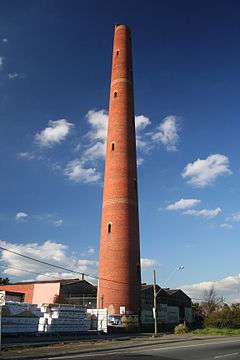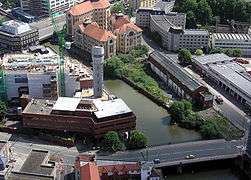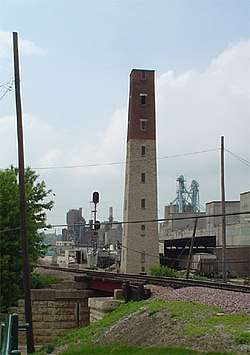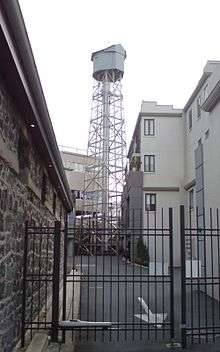Shot tower





A shot tower is a tower designed for the production of small diameter shot balls by freefall of molten lead, which is then caught in a water basin. The shot is primarily used for projectiles in shotguns, and also for ballast, radiation shielding and other applications where small lead balls are useful.
Shot making
Process
In a shot tower, lead is heated until molten, then dropped through a copper sieve high in the tower. The liquid lead forms tiny spherical balls by surface tension, and solidifies as it falls. The partially cooled balls are caught at the floor of the tower in a water-filled basin.[1] The now fully cooled balls are checked for roundness and sorted by size; those that are "out of round" are remelted. A slightly inclined table is used for checking roundness.[2] To make larger shot sizes, a copper sieve with larger holes is used. The maximum size is limited by the height of the tower, because larger shot sizes must fall farther to solidify. A shot tower with a 40-meter drop can produce up to #6 shot (nominally 2.4mm in diameter) while an 80-meter drop can produce #2 shot (nominally 3.8mm in diameter).[3] Polishing with a small amount of graphite is necessary for lubrication and to prevent oxidation.
History
The process was invented by William Watts of Bristol, UK, and patented in 1782.[1][4] The same year, Watts extended his house in Redcliffe, Bristol to build the first shot tower.[5] Use of shot towers replaced earlier techniques of casting shot in moulds, which was expensive, or of dripping molten lead into water barrels, which produced insufficiently spherical balls. Large shot which could not be made by the shot tower was made by tumbling pieces of cut lead sheet in a barrel until round.[6]
The "wind tower" method, patented in 1848 by the T.O LeRoy Company of New York City, which used a blast of cold air to dramatically shorten the drop necessary[7][8] meant that tall shot towers became unnecessary, but many were still constructed into the late 1880s, and two surviving examples date from 1916 and 1969. Since the 1960s the Bliemeister method is used to make smaller shot sizes, and larger sizes are made by the cold swaging process of feeding calibrated lengths of wire into hemispherical dies and stamping them into spheres.[9]
Examples

| Name | Location | Country | Year | Notes |
|---|---|---|---|---|
| Berlin Shot Ball Tower | Berlin Rummelsburg | Germany | 1908 | Nöldnerstraße 15 and 16. Used until 1939 |
| Brussels Shot Tower | Brussels | Belgium | 1885 | Kruitmolenstraat 60. Used until 1962. It is a circular brick tower 46 m high, with a diameter of 4.7 m at the base and 3.1 m at the top. Classified as cultural heritage since 1984. It stands at the site of a former black gunpowder factory known as 'La Poudrière'. |
| Cheese Lane Shot Tower | Bristol, England | United Kingdom | 1969 | A reinforced concrete tower built to replace the very first shot tower built in Redcliffe by William Watts[10] |
| Chester Shot Tower | Boughton, England | United Kingdom | 1799 | A circular brick tower; the oldest surviving shot tower in the UK[11] |
| Clifton Hill Shot Tower | Melbourne, Victoria | Australia | 1882 | A brick structure that is 80.1 m (263 ft) high.[12] And the tallest remaining in Australia[13] |
| Colonial Ammunition Company | Mt Eden, Auckland | New Zealand | 1916 | A steel framed tower[14] |
| Coop's Shot Tower | Melbourne, Victoria | Australia | 1888 | 50 meters (160 ft) high[15] |
| Cox's Lead Works Shot Tower | Derby, England | United Kingdom | 1809 | Demolished to make way for the development of Corporation Street in 1932 |
| Daugavpils Shot Factory Tower | Daugavpils | Latvia | ? | Still in operation[16][17] |
| Drochtersen Shot Tower | Drochtersen, Lower Saxony | Germany | ? | |
| Dubuque Shot Tower | Dubuque, Iowa | United States | 1856 | |
| Fort Hayes Shot Tower | Columbus, Ohio | United States | 1864 | Currently in use with the Fort Hayes Metropolitan Education Center |
| Helena Shot Tower | Spring Green, Wisconsin | United States | 1831 | Preserved as part of a state park[18] |
| Jackson Ferry Shot Tower | Wythe County, Virginia | United States | 1790s | Now part of a state park and open to the public during the tourist season.[19] |
| Lambeth Shot Tower | London, England | United Kingdom | 1826 | In use until 1949, and was a feature in the 1951 Festival of Britain, before being demolished. |
| McCullough Tower | Lower Manhattan, New York | United States | 1855-6 | The first shot tower constructed of an iron frame rather than masonry. Built by James Bogardus with a height of 175 ft (53 m). Demolished 1907.[20] |
| New Vienna Shot Tower | New Vienna, Iowa | United States | ? | |
| Peters Shot Tower | Kings Mills, Ohio | United States | 1895 | |
| Pispala Shot Tower | Pispala, Tampere | Finland | 1908 | Height 55 m (180 ft). Used until 1972. |
| Phoenix Shot Tower | Baltimore, Maryland | United States | 1828 | |
| Redcliffe Shot Tower | Bristol, England | United Kingdom | 1782 | The first shot tower, built by William Watts, the inventor of the tower process for the manufacture of lead shot. Demolished in 1968.[10] |
| Remington Shot Tower | Lonoke, Arkansas | United States | 1969 | Moved from Bridgeport, Connecticut[21]. |
| Rossie Shot Tower | Rossie, New York | United States | ? | |
| Sparks Shot Tower | Philadelphia, Pennsylvania | United States | 1808 | In use until 1913. Now part of a children's playground |
| Stelco Shot Tower | Montreal, Quebec | Canada | ? | [22] |
| Tapham Tower | Lower Manhattan, New York | United States | 1855-6 | Built by James Bogardus with a height of 217 ft (66 m). Demolished in the first decade of the 20th century. |
| Taroona Shot Tower | Hobart, Tasmania | Australia | 1870 | |
| Torre de los Perdigones | Seville | Spain | 1885 | |
| Winchester Shot Tower | New Haven, Connecticut | United States | ? | |
See also
- Drop tube, a similar concept, but used for scientific experiments
- Prill, a small granule of material formed by a similar process to shot-making. Often used in the chemical industry for solid chemicals.
- Spray drying is a process of turning liquids into powder; many spray dryers also have the drops of liquid solidifying as they drop in a tower.
Further reading
- "Up a shot tower". The Strand Magazine. 1891. p. 205.
References
- 1 2 "No. 422: Shot Tower", Engines, UH .
- ↑ Re: How the small lead shot (7–8 sizes) used for shotgun shells are made?, Mad sci, May 2001 .
- ↑ The Physics of Shot Towers (PDF)
- ↑ Minchinton, Walter (1993). "The Shot Tower" (PDF). The Shot Peener. 7 (3): 22.
- ↑ "Sheldon Bush and Patent Shot Company Limited, Cheese Lane, Bristol", Images of England .
- ↑ "150th", The Age, Melbourne, AU, archived from the original on 2006-02-12 .
- ↑ "Archived copy". Archived from the original on 2012-01-30. Retrieved 2013-09-12. , Lynne Belluscio, LeRoy Penny Saver News
- ↑ History of the American Shot Tower Archived August 11, 2005, at the Wayback Machine.
- ↑ "The romance of lead shot - Shotgunner – Guns Magazine – Find Articles at BNET.com". Archived from the original on 2006-05-05.
- 1 2 Efstathios, Tsolis (2007-03-10). "An Awkward thing" (PDF). University of Bristol. Retrieved 2015-03-19.
- ↑ "Chester Leadworks and Shot Tower", Images of England .
- ↑ Heritage, Victoria, AU .
- ↑ "Melbourne Central - Our Heritage". www.melbournecentral.com.au. Retrieved 2017-02-15.
- ↑ "Colonial Ammunition Company Shot Tower". Register of Historic Places. Heritage New Zealand. Retrieved 2010-03-02.
- ↑ "Victorian heritage directory". vhd.heritagecouncil.vic.gov.au. Retrieved 2017-02-15.
- ↑ DSR, LV .
- ↑ "Daugavpils Lead Shot Factory". Official Latvian Tourism Portal. Latvian Tourism Development Agency. 12 June 2013. Retrieved 12 September 2013.
- ↑ Tower Hill State Park Shot Tower, WI, US .
- ↑ Shot Tower Historical State Park, VA, US
- ↑ Gayle, Margot; Gayle, Carol (1998). Cast-iron Architecture in America: The Significance of James Bogardus. W. W. Norton & Company. pp. 169–174. ISBN 0393730158.
- ↑ "Remington Ammunition & Components Plant - Lonoke, AR". Waymarking.com. Retrieved 5 July 2017.
- ↑ http://www.waymarking.com/waymarks/WMDXNA_Montreal_Shot_Tower_Montreal_Qc_Canada
External links
| Wikimedia Commons has media related to Shot towers. |
- "Gravity Molds Shot In A Modern Tower", October 1944, Popular Science detailed and large article on subject of Shot Towers